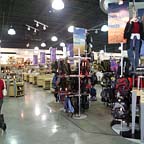Dressing Up EAS

In the end, their decision was between Checkpoint Systems of Thorofare, N.J., and one rival. Each installed its EAS system for Gordman’s on a nine-month trial. Checkpoint emerged the winner, and Gordman’s has never looked back.
Service impact
"Technology offers tremendous advantages in loss protection, until the day you need help getting it to work properly," said Rich Palmer, Gordman’s director of asset protection. "Many vendors put all their energy into the sale, and once you buy you never see them again. Checkpoint took a chance on us when we were a small company, made a commitment to us and lived up to it." Both sides have clearly benefited.Gordman’s rolled the system out to its 24-store network. Inventory shrinkage immediately started to decline as internal theft was sharply curtailed. Since then, the chain has grown to 45 locations in 10 states, and Checkpoint’s EAS serves all but one of them. Palmer estimated that shrinkage would be 0.5 to 0.75 points higher without EAS, which now includes source tagging, radio frequency identification and integrated labeling. "We hold the stores to very high standards of compliance, and Checkpoint supports that," he noted.
The Gordman’s tradition of continuously improving on the status quo found a willing partner. Beginning in 2001, Gordman’s began using Clarity Passport fire and burglary protection system and security video, which have become standard features of every new store in the still-growing Gordman’s network. Four more stores are planned to open before the end of 2004.
A time saver
"Checkpoint’s service to Gordman’s allows us to deliver better service to our customers, which in turns fuels our expansion," said Palmer. Prior to that, store managers spent too much time on internal issues such as false alarms that brought the fire department to the door or the effort of trying to catch employee thieves in the act. Now they have more time to direct their focus more profitably on ways to attract and keep customers.Beyond typical EAS and retail security such as those at Gordman's Stores, protection and inventory controls are transforming thanks to the improvements in technology and the concept of source tagging. The latter is the process of building a read or read/write tag into a product, package or pallet. The item can then be tracked for a diversity of purposes from manufacturing and distribution to warehousing and onto the store floor.
With annual inventory shrinkage losses of $33 billion in the United States and 28.9 billion in Western Europe, retailers are demanding such new solutions to recover lost profits. So it’s no wonder that EAS source tagging is widely recognized as a solution.
The embedding of disposable security labels at the point of manufacture or packaging can, according to some retail security executives, improve profitability, reduce shrinkage and increase sales by taking items merchandise out of lock-up.
On the retail side, EAS source tagging can reduce or eliminate labor costs for in-store tagging, reduce training requirements while discouraging employee theft.
Looking for a reprint of this article?
From high-res PDFs to custom plaques, order your copy today!



